Analyzing Tourism: Socio-Cultural Perspectives and Impacts Report
VerifiedAdded on 2020/03/04
|17
|4970
|181
Report
AI Summary
This report provides a comprehensive analysis of tourism from a socio-cultural perspective. It begins with an introduction that highlights the dual aspects and uneven distribution of merits and demerits associated with the tourism industry. The report then delves into key concepts and theories, including Social Exchange Theory, Social Disruption Theory, Social Carrying Capacity Theory, and Butler’s Model of Tourism, to provide a theoretical foundation for understanding tourism's impacts. The discussion section explores the socio-cultural impacts of tourism, examining both positive and negative effects on host destinations. The report examines how cultural factors, personal factors, and socio-economic factors influence the perceptions of local residents towards the tourism business. The report then concludes with a thorough summary of the key findings, emphasizing the complex and often contradictory nature of tourism's socio-cultural effects.

Running head: Tourism and Travel 1
Paraphrase This Document
Need a fresh take? Get an instant paraphrase of this document with our AI Paraphraser
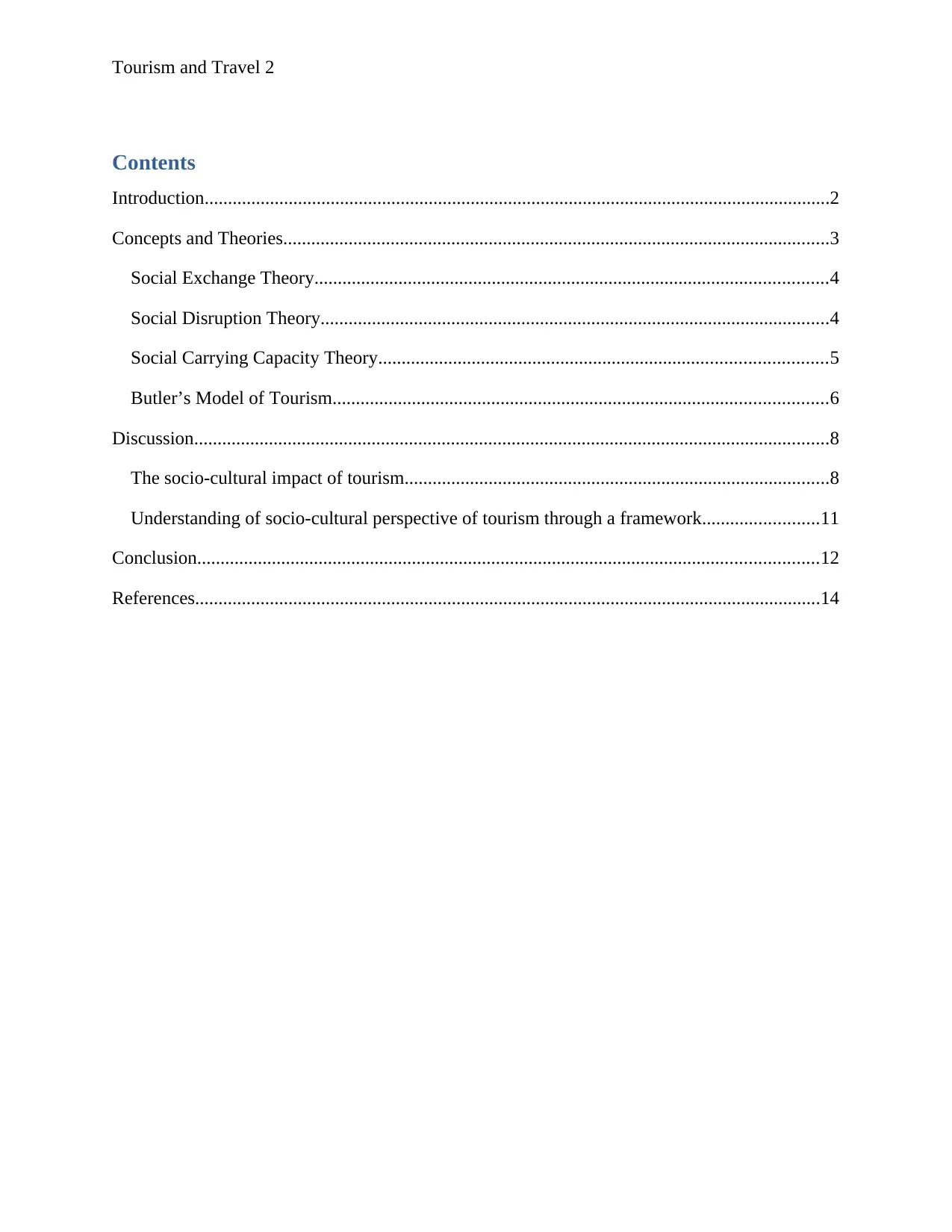
Tourism and Travel 2
Contents
Introduction......................................................................................................................................2
Concepts and Theories.....................................................................................................................3
Social Exchange Theory..............................................................................................................4
Social Disruption Theory.............................................................................................................4
Social Carrying Capacity Theory................................................................................................5
Butler’s Model of Tourism..........................................................................................................6
Discussion........................................................................................................................................8
The socio-cultural impact of tourism...........................................................................................8
Understanding of socio-cultural perspective of tourism through a framework.........................11
Conclusion.....................................................................................................................................12
References......................................................................................................................................14
Contents
Introduction......................................................................................................................................2
Concepts and Theories.....................................................................................................................3
Social Exchange Theory..............................................................................................................4
Social Disruption Theory.............................................................................................................4
Social Carrying Capacity Theory................................................................................................5
Butler’s Model of Tourism..........................................................................................................6
Discussion........................................................................................................................................8
The socio-cultural impact of tourism...........................................................................................8
Understanding of socio-cultural perspective of tourism through a framework.........................11
Conclusion.....................................................................................................................................12
References......................................................................................................................................14
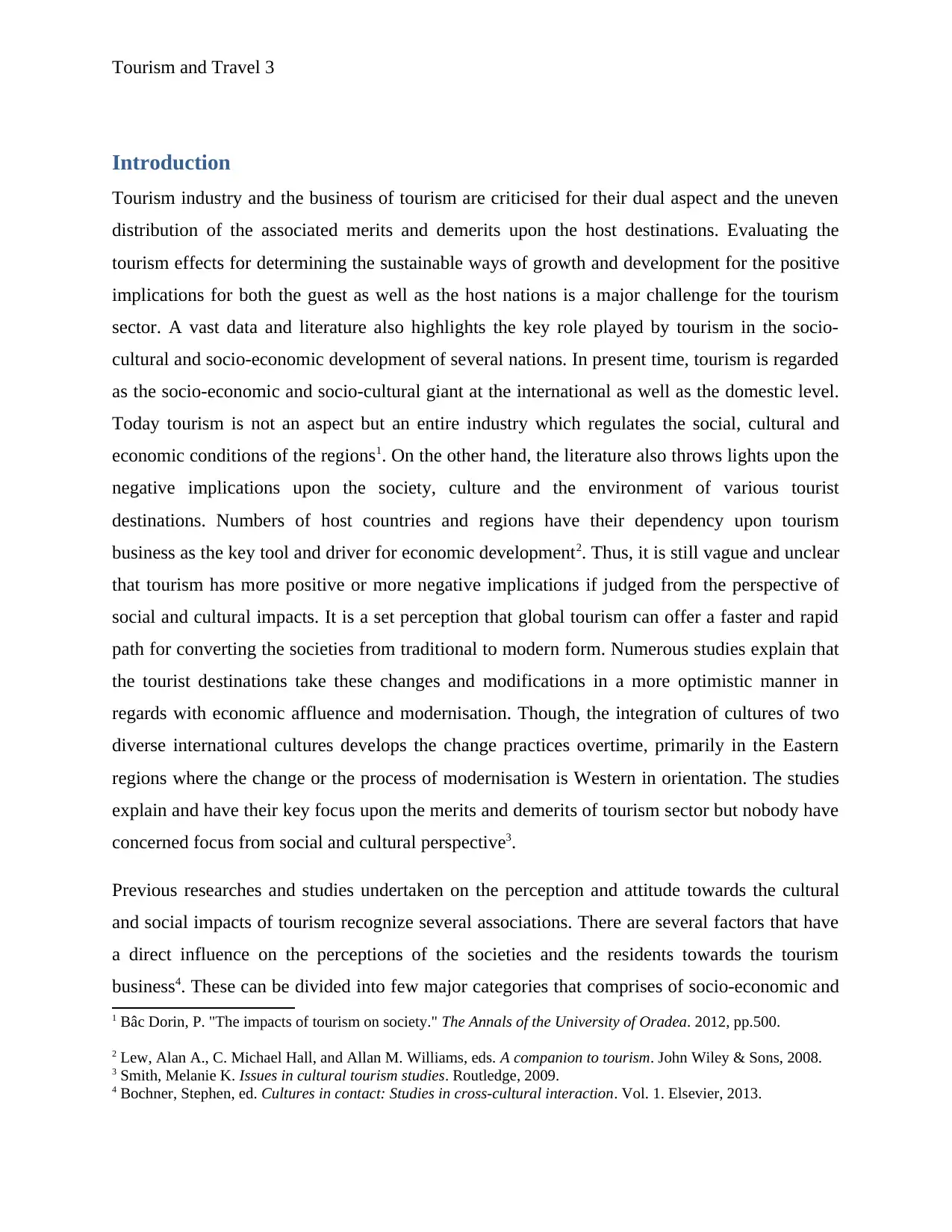
Tourism and Travel 3
Introduction
Tourism industry and the business of tourism are criticised for their dual aspect and the uneven
distribution of the associated merits and demerits upon the host destinations. Evaluating the
tourism effects for determining the sustainable ways of growth and development for the positive
implications for both the guest as well as the host nations is a major challenge for the tourism
sector. A vast data and literature also highlights the key role played by tourism in the socio-
cultural and socio-economic development of several nations. In present time, tourism is regarded
as the socio-economic and socio-cultural giant at the international as well as the domestic level.
Today tourism is not an aspect but an entire industry which regulates the social, cultural and
economic conditions of the regions1. On the other hand, the literature also throws lights upon the
negative implications upon the society, culture and the environment of various tourist
destinations. Numbers of host countries and regions have their dependency upon tourism
business as the key tool and driver for economic development2. Thus, it is still vague and unclear
that tourism has more positive or more negative implications if judged from the perspective of
social and cultural impacts. It is a set perception that global tourism can offer a faster and rapid
path for converting the societies from traditional to modern form. Numerous studies explain that
the tourist destinations take these changes and modifications in a more optimistic manner in
regards with economic affluence and modernisation. Though, the integration of cultures of two
diverse international cultures develops the change practices overtime, primarily in the Eastern
regions where the change or the process of modernisation is Western in orientation. The studies
explain and have their key focus upon the merits and demerits of tourism sector but nobody have
concerned focus from social and cultural perspective3.
Previous researches and studies undertaken on the perception and attitude towards the cultural
and social impacts of tourism recognize several associations. There are several factors that have
a direct influence on the perceptions of the societies and the residents towards the tourism
business4. These can be divided into few major categories that comprises of socio-economic and
1 Bâc Dorin, P. "The impacts of tourism on society." The Annals of the University of Oradea. 2012, pp.500.
2 Lew, Alan A., C. Michael Hall, and Allan M. Williams, eds. A companion to tourism. John Wiley & Sons, 2008.
3 Smith, Melanie K. Issues in cultural tourism studies. Routledge, 2009.
4 Bochner, Stephen, ed. Cultures in contact: Studies in cross-cultural interaction. Vol. 1. Elsevier, 2013.
Introduction
Tourism industry and the business of tourism are criticised for their dual aspect and the uneven
distribution of the associated merits and demerits upon the host destinations. Evaluating the
tourism effects for determining the sustainable ways of growth and development for the positive
implications for both the guest as well as the host nations is a major challenge for the tourism
sector. A vast data and literature also highlights the key role played by tourism in the socio-
cultural and socio-economic development of several nations. In present time, tourism is regarded
as the socio-economic and socio-cultural giant at the international as well as the domestic level.
Today tourism is not an aspect but an entire industry which regulates the social, cultural and
economic conditions of the regions1. On the other hand, the literature also throws lights upon the
negative implications upon the society, culture and the environment of various tourist
destinations. Numbers of host countries and regions have their dependency upon tourism
business as the key tool and driver for economic development2. Thus, it is still vague and unclear
that tourism has more positive or more negative implications if judged from the perspective of
social and cultural impacts. It is a set perception that global tourism can offer a faster and rapid
path for converting the societies from traditional to modern form. Numerous studies explain that
the tourist destinations take these changes and modifications in a more optimistic manner in
regards with economic affluence and modernisation. Though, the integration of cultures of two
diverse international cultures develops the change practices overtime, primarily in the Eastern
regions where the change or the process of modernisation is Western in orientation. The studies
explain and have their key focus upon the merits and demerits of tourism sector but nobody have
concerned focus from social and cultural perspective3.
Previous researches and studies undertaken on the perception and attitude towards the cultural
and social impacts of tourism recognize several associations. There are several factors that have
a direct influence on the perceptions of the societies and the residents towards the tourism
business4. These can be divided into few major categories that comprises of socio-economic and
1 Bâc Dorin, P. "The impacts of tourism on society." The Annals of the University of Oradea. 2012, pp.500.
2 Lew, Alan A., C. Michael Hall, and Allan M. Williams, eds. A companion to tourism. John Wiley & Sons, 2008.
3 Smith, Melanie K. Issues in cultural tourism studies. Routledge, 2009.
4 Bochner, Stephen, ed. Cultures in contact: Studies in cross-cultural interaction. Vol. 1. Elsevier, 2013.
⊘ This is a preview!⊘
Do you want full access?
Subscribe today to unlock all pages.

Trusted by 1+ million students worldwide
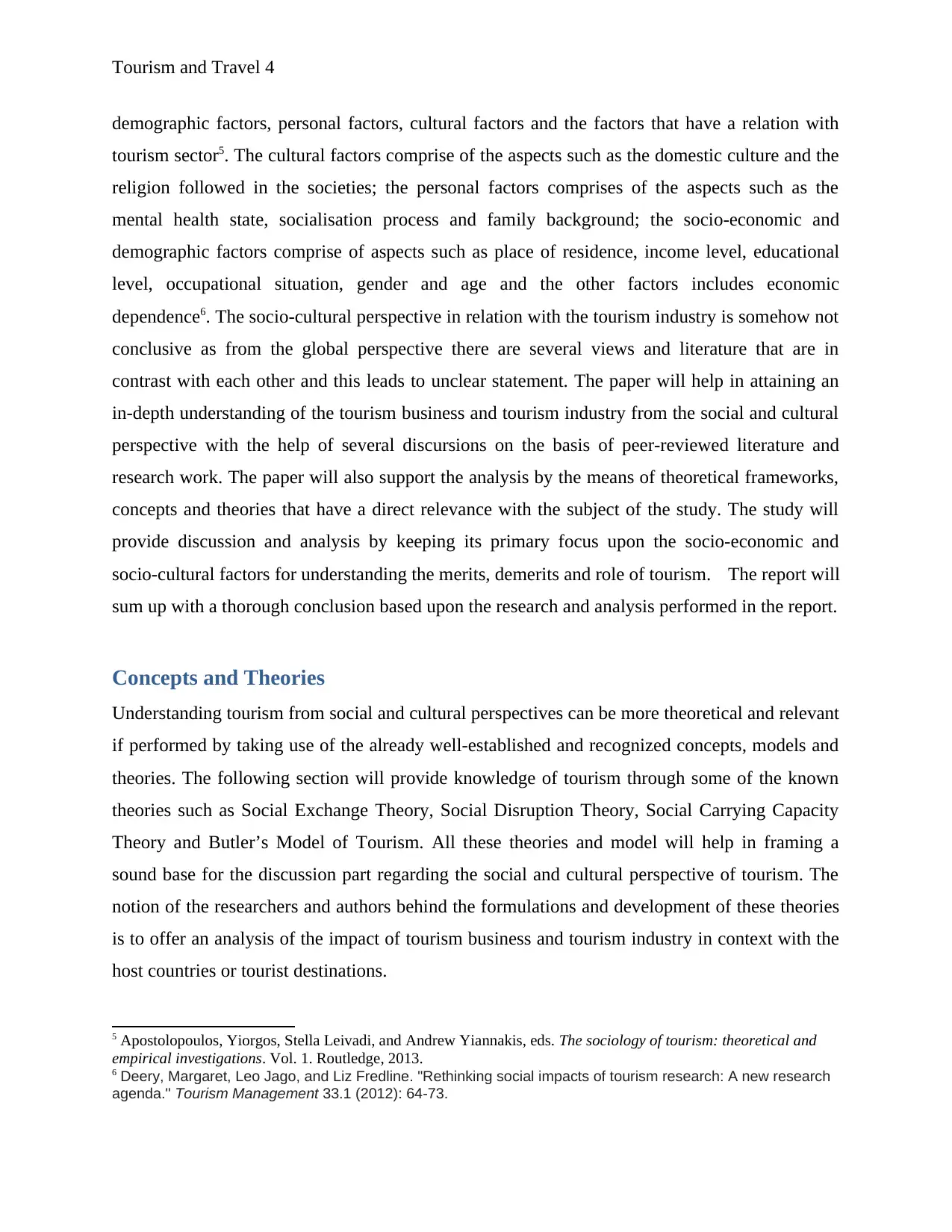
Tourism and Travel 4
demographic factors, personal factors, cultural factors and the factors that have a relation with
tourism sector5. The cultural factors comprise of the aspects such as the domestic culture and the
religion followed in the societies; the personal factors comprises of the aspects such as the
mental health state, socialisation process and family background; the socio-economic and
demographic factors comprise of aspects such as place of residence, income level, educational
level, occupational situation, gender and age and the other factors includes economic
dependence6. The socio-cultural perspective in relation with the tourism industry is somehow not
conclusive as from the global perspective there are several views and literature that are in
contrast with each other and this leads to unclear statement. The paper will help in attaining an
in-depth understanding of the tourism business and tourism industry from the social and cultural
perspective with the help of several discursions on the basis of peer-reviewed literature and
research work. The paper will also support the analysis by the means of theoretical frameworks,
concepts and theories that have a direct relevance with the subject of the study. The study will
provide discussion and analysis by keeping its primary focus upon the socio-economic and
socio-cultural factors for understanding the merits, demerits and role of tourism. The report will
sum up with a thorough conclusion based upon the research and analysis performed in the report.
Concepts and Theories
Understanding tourism from social and cultural perspectives can be more theoretical and relevant
if performed by taking use of the already well-established and recognized concepts, models and
theories. The following section will provide knowledge of tourism through some of the known
theories such as Social Exchange Theory, Social Disruption Theory, Social Carrying Capacity
Theory and Butler’s Model of Tourism. All these theories and model will help in framing a
sound base for the discussion part regarding the social and cultural perspective of tourism. The
notion of the researchers and authors behind the formulations and development of these theories
is to offer an analysis of the impact of tourism business and tourism industry in context with the
host countries or tourist destinations.
5 Apostolopoulos, Yiorgos, Stella Leivadi, and Andrew Yiannakis, eds. The sociology of tourism: theoretical and
empirical investigations. Vol. 1. Routledge, 2013.
6 Deery, Margaret, Leo Jago, and Liz Fredline. "Rethinking social impacts of tourism research: A new research
agenda." Tourism Management 33.1 (2012): 64-73.
demographic factors, personal factors, cultural factors and the factors that have a relation with
tourism sector5. The cultural factors comprise of the aspects such as the domestic culture and the
religion followed in the societies; the personal factors comprises of the aspects such as the
mental health state, socialisation process and family background; the socio-economic and
demographic factors comprise of aspects such as place of residence, income level, educational
level, occupational situation, gender and age and the other factors includes economic
dependence6. The socio-cultural perspective in relation with the tourism industry is somehow not
conclusive as from the global perspective there are several views and literature that are in
contrast with each other and this leads to unclear statement. The paper will help in attaining an
in-depth understanding of the tourism business and tourism industry from the social and cultural
perspective with the help of several discursions on the basis of peer-reviewed literature and
research work. The paper will also support the analysis by the means of theoretical frameworks,
concepts and theories that have a direct relevance with the subject of the study. The study will
provide discussion and analysis by keeping its primary focus upon the socio-economic and
socio-cultural factors for understanding the merits, demerits and role of tourism. The report will
sum up with a thorough conclusion based upon the research and analysis performed in the report.
Concepts and Theories
Understanding tourism from social and cultural perspectives can be more theoretical and relevant
if performed by taking use of the already well-established and recognized concepts, models and
theories. The following section will provide knowledge of tourism through some of the known
theories such as Social Exchange Theory, Social Disruption Theory, Social Carrying Capacity
Theory and Butler’s Model of Tourism. All these theories and model will help in framing a
sound base for the discussion part regarding the social and cultural perspective of tourism. The
notion of the researchers and authors behind the formulations and development of these theories
is to offer an analysis of the impact of tourism business and tourism industry in context with the
host countries or tourist destinations.
5 Apostolopoulos, Yiorgos, Stella Leivadi, and Andrew Yiannakis, eds. The sociology of tourism: theoretical and
empirical investigations. Vol. 1. Routledge, 2013.
6 Deery, Margaret, Leo Jago, and Liz Fredline. "Rethinking social impacts of tourism research: A new research
agenda." Tourism Management 33.1 (2012): 64-73.
Paraphrase This Document
Need a fresh take? Get an instant paraphrase of this document with our AI Paraphraser
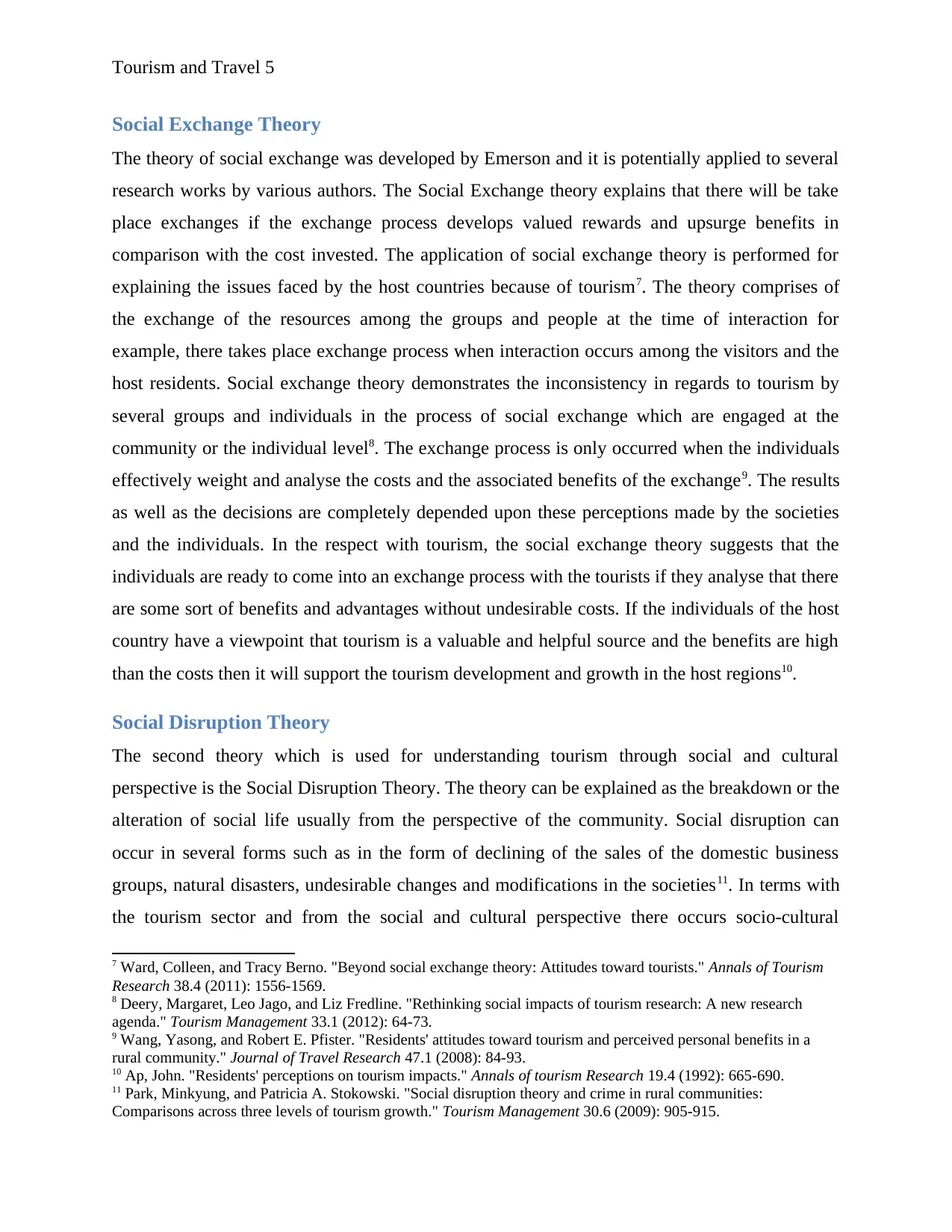
Tourism and Travel 5
Social Exchange Theory
The theory of social exchange was developed by Emerson and it is potentially applied to several
research works by various authors. The Social Exchange theory explains that there will be take
place exchanges if the exchange process develops valued rewards and upsurge benefits in
comparison with the cost invested. The application of social exchange theory is performed for
explaining the issues faced by the host countries because of tourism7. The theory comprises of
the exchange of the resources among the groups and people at the time of interaction for
example, there takes place exchange process when interaction occurs among the visitors and the
host residents. Social exchange theory demonstrates the inconsistency in regards to tourism by
several groups and individuals in the process of social exchange which are engaged at the
community or the individual level8. The exchange process is only occurred when the individuals
effectively weight and analyse the costs and the associated benefits of the exchange9. The results
as well as the decisions are completely depended upon these perceptions made by the societies
and the individuals. In the respect with tourism, the social exchange theory suggests that the
individuals are ready to come into an exchange process with the tourists if they analyse that there
are some sort of benefits and advantages without undesirable costs. If the individuals of the host
country have a viewpoint that tourism is a valuable and helpful source and the benefits are high
than the costs then it will support the tourism development and growth in the host regions10.
Social Disruption Theory
The second theory which is used for understanding tourism through social and cultural
perspective is the Social Disruption Theory. The theory can be explained as the breakdown or the
alteration of social life usually from the perspective of the community. Social disruption can
occur in several forms such as in the form of declining of the sales of the domestic business
groups, natural disasters, undesirable changes and modifications in the societies11. In terms with
the tourism sector and from the social and cultural perspective there occurs socio-cultural
7 Ward, Colleen, and Tracy Berno. "Beyond social exchange theory: Attitudes toward tourists." Annals of Tourism
Research 38.4 (2011): 1556-1569.
8 Deery, Margaret, Leo Jago, and Liz Fredline. "Rethinking social impacts of tourism research: A new research
agenda." Tourism Management 33.1 (2012): 64-73.
9 Wang, Yasong, and Robert E. Pfister. "Residents' attitudes toward tourism and perceived personal benefits in a
rural community." Journal of Travel Research 47.1 (2008): 84-93.
10 Ap, John. "Residents' perceptions on tourism impacts." Annals of tourism Research 19.4 (1992): 665-690.
11 Park, Minkyung, and Patricia A. Stokowski. "Social disruption theory and crime in rural communities:
Comparisons across three levels of tourism growth." Tourism Management 30.6 (2009): 905-915.
Social Exchange Theory
The theory of social exchange was developed by Emerson and it is potentially applied to several
research works by various authors. The Social Exchange theory explains that there will be take
place exchanges if the exchange process develops valued rewards and upsurge benefits in
comparison with the cost invested. The application of social exchange theory is performed for
explaining the issues faced by the host countries because of tourism7. The theory comprises of
the exchange of the resources among the groups and people at the time of interaction for
example, there takes place exchange process when interaction occurs among the visitors and the
host residents. Social exchange theory demonstrates the inconsistency in regards to tourism by
several groups and individuals in the process of social exchange which are engaged at the
community or the individual level8. The exchange process is only occurred when the individuals
effectively weight and analyse the costs and the associated benefits of the exchange9. The results
as well as the decisions are completely depended upon these perceptions made by the societies
and the individuals. In the respect with tourism, the social exchange theory suggests that the
individuals are ready to come into an exchange process with the tourists if they analyse that there
are some sort of benefits and advantages without undesirable costs. If the individuals of the host
country have a viewpoint that tourism is a valuable and helpful source and the benefits are high
than the costs then it will support the tourism development and growth in the host regions10.
Social Disruption Theory
The second theory which is used for understanding tourism through social and cultural
perspective is the Social Disruption Theory. The theory can be explained as the breakdown or the
alteration of social life usually from the perspective of the community. Social disruption can
occur in several forms such as in the form of declining of the sales of the domestic business
groups, natural disasters, undesirable changes and modifications in the societies11. In terms with
the tourism sector and from the social and cultural perspective there occurs socio-cultural
7 Ward, Colleen, and Tracy Berno. "Beyond social exchange theory: Attitudes toward tourists." Annals of Tourism
Research 38.4 (2011): 1556-1569.
8 Deery, Margaret, Leo Jago, and Liz Fredline. "Rethinking social impacts of tourism research: A new research
agenda." Tourism Management 33.1 (2012): 64-73.
9 Wang, Yasong, and Robert E. Pfister. "Residents' attitudes toward tourism and perceived personal benefits in a
rural community." Journal of Travel Research 47.1 (2008): 84-93.
10 Ap, John. "Residents' perceptions on tourism impacts." Annals of tourism Research 19.4 (1992): 665-690.
11 Park, Minkyung, and Patricia A. Stokowski. "Social disruption theory and crime in rural communities:
Comparisons across three levels of tourism growth." Tourism Management 30.6 (2009): 905-915.
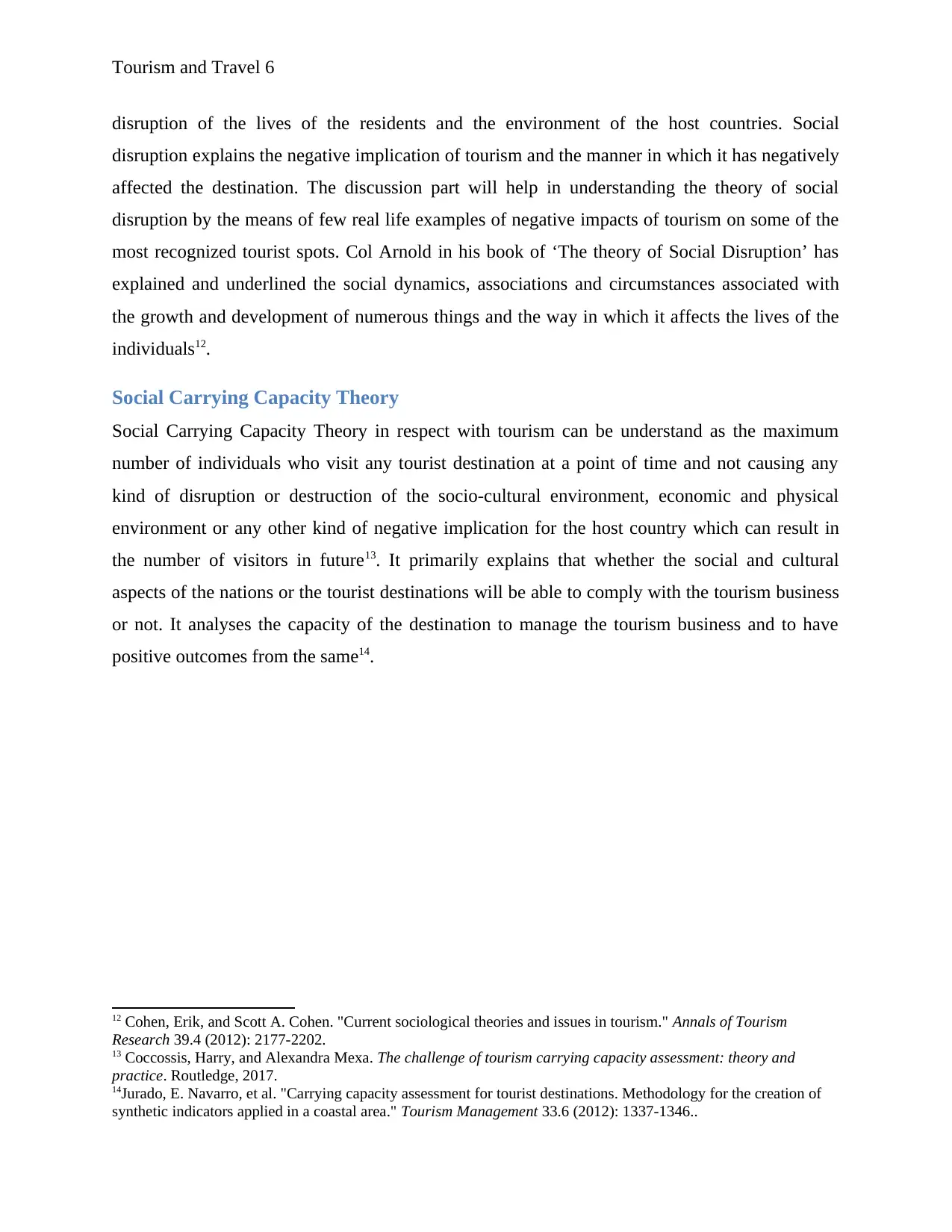
Tourism and Travel 6
disruption of the lives of the residents and the environment of the host countries. Social
disruption explains the negative implication of tourism and the manner in which it has negatively
affected the destination. The discussion part will help in understanding the theory of social
disruption by the means of few real life examples of negative impacts of tourism on some of the
most recognized tourist spots. Col Arnold in his book of ‘The theory of Social Disruption’ has
explained and underlined the social dynamics, associations and circumstances associated with
the growth and development of numerous things and the way in which it affects the lives of the
individuals12.
Social Carrying Capacity Theory
Social Carrying Capacity Theory in respect with tourism can be understand as the maximum
number of individuals who visit any tourist destination at a point of time and not causing any
kind of disruption or destruction of the socio-cultural environment, economic and physical
environment or any other kind of negative implication for the host country which can result in
the number of visitors in future13. It primarily explains that whether the social and cultural
aspects of the nations or the tourist destinations will be able to comply with the tourism business
or not. It analyses the capacity of the destination to manage the tourism business and to have
positive outcomes from the same14.
12 Cohen, Erik, and Scott A. Cohen. "Current sociological theories and issues in tourism." Annals of Tourism
Research 39.4 (2012): 2177-2202.
13 Coccossis, Harry, and Alexandra Mexa. The challenge of tourism carrying capacity assessment: theory and
practice. Routledge, 2017.
14Jurado, E. Navarro, et al. "Carrying capacity assessment for tourist destinations. Methodology for the creation of
synthetic indicators applied in a coastal area." Tourism Management 33.6 (2012): 1337-1346..
disruption of the lives of the residents and the environment of the host countries. Social
disruption explains the negative implication of tourism and the manner in which it has negatively
affected the destination. The discussion part will help in understanding the theory of social
disruption by the means of few real life examples of negative impacts of tourism on some of the
most recognized tourist spots. Col Arnold in his book of ‘The theory of Social Disruption’ has
explained and underlined the social dynamics, associations and circumstances associated with
the growth and development of numerous things and the way in which it affects the lives of the
individuals12.
Social Carrying Capacity Theory
Social Carrying Capacity Theory in respect with tourism can be understand as the maximum
number of individuals who visit any tourist destination at a point of time and not causing any
kind of disruption or destruction of the socio-cultural environment, economic and physical
environment or any other kind of negative implication for the host country which can result in
the number of visitors in future13. It primarily explains that whether the social and cultural
aspects of the nations or the tourist destinations will be able to comply with the tourism business
or not. It analyses the capacity of the destination to manage the tourism business and to have
positive outcomes from the same14.
12 Cohen, Erik, and Scott A. Cohen. "Current sociological theories and issues in tourism." Annals of Tourism
Research 39.4 (2012): 2177-2202.
13 Coccossis, Harry, and Alexandra Mexa. The challenge of tourism carrying capacity assessment: theory and
practice. Routledge, 2017.
14Jurado, E. Navarro, et al. "Carrying capacity assessment for tourist destinations. Methodology for the creation of
synthetic indicators applied in a coastal area." Tourism Management 33.6 (2012): 1337-1346..
⊘ This is a preview!⊘
Do you want full access?
Subscribe today to unlock all pages.

Trusted by 1+ million students worldwide
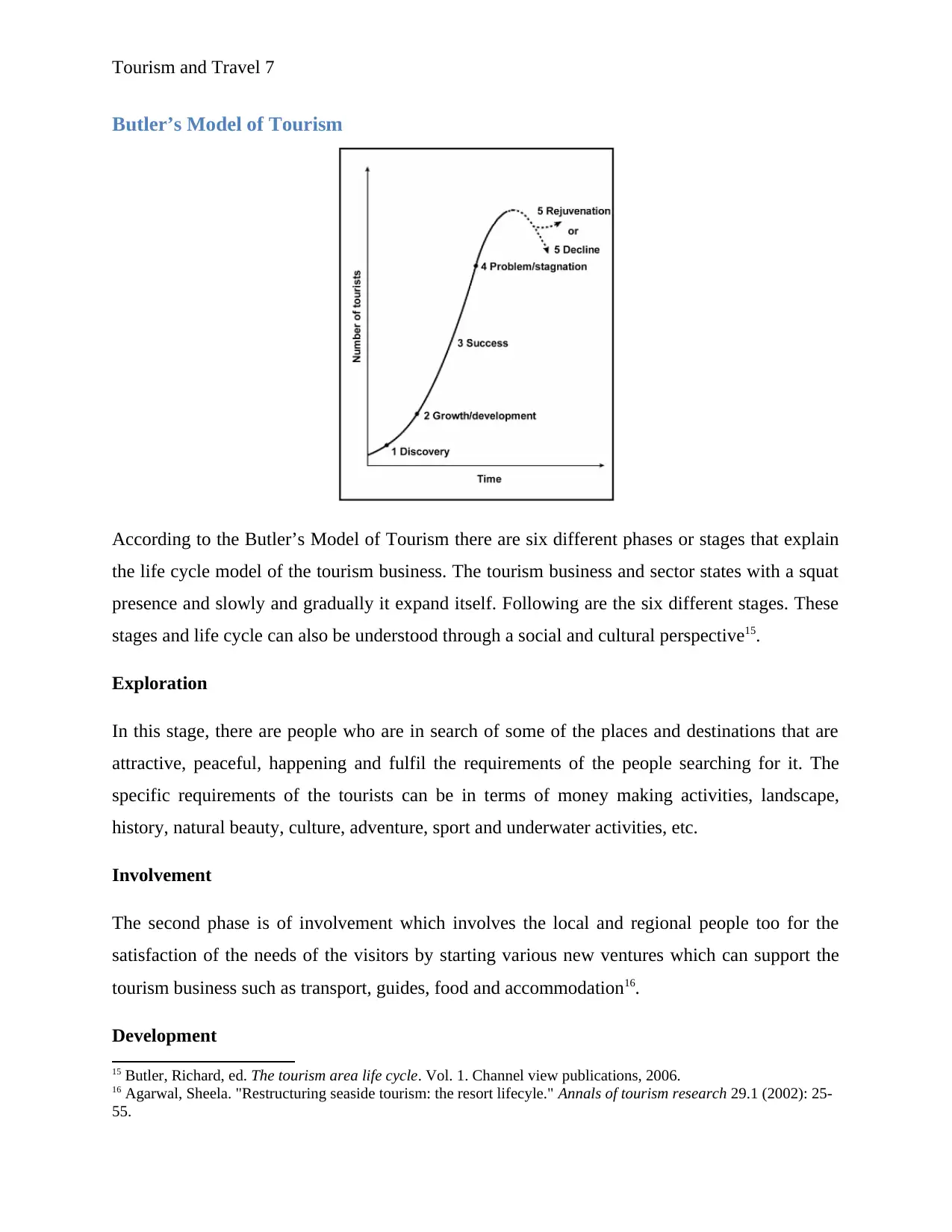
Tourism and Travel 7
Butler’s Model of Tourism
According to the Butler’s Model of Tourism there are six different phases or stages that explain
the life cycle model of the tourism business. The tourism business and sector states with a squat
presence and slowly and gradually it expand itself. Following are the six different stages. These
stages and life cycle can also be understood through a social and cultural perspective15.
Exploration
In this stage, there are people who are in search of some of the places and destinations that are
attractive, peaceful, happening and fulfil the requirements of the people searching for it. The
specific requirements of the tourists can be in terms of money making activities, landscape,
history, natural beauty, culture, adventure, sport and underwater activities, etc.
Involvement
The second phase is of involvement which involves the local and regional people too for the
satisfaction of the needs of the visitors by starting various new ventures which can support the
tourism business such as transport, guides, food and accommodation16.
Development
15 Butler, Richard, ed. The tourism area life cycle. Vol. 1. Channel view publications, 2006.
16 Agarwal, Sheela. "Restructuring seaside tourism: the resort lifecyle." Annals of tourism research 29.1 (2002): 25-
55.
Butler’s Model of Tourism
According to the Butler’s Model of Tourism there are six different phases or stages that explain
the life cycle model of the tourism business. The tourism business and sector states with a squat
presence and slowly and gradually it expand itself. Following are the six different stages. These
stages and life cycle can also be understood through a social and cultural perspective15.
Exploration
In this stage, there are people who are in search of some of the places and destinations that are
attractive, peaceful, happening and fulfil the requirements of the people searching for it. The
specific requirements of the tourists can be in terms of money making activities, landscape,
history, natural beauty, culture, adventure, sport and underwater activities, etc.
Involvement
The second phase is of involvement which involves the local and regional people too for the
satisfaction of the needs of the visitors by starting various new ventures which can support the
tourism business such as transport, guides, food and accommodation16.
Development
15 Butler, Richard, ed. The tourism area life cycle. Vol. 1. Channel view publications, 2006.
16 Agarwal, Sheela. "Restructuring seaside tourism: the resort lifecyle." Annals of tourism research 29.1 (2002): 25-
55.
Paraphrase This Document
Need a fresh take? Get an instant paraphrase of this document with our AI Paraphraser
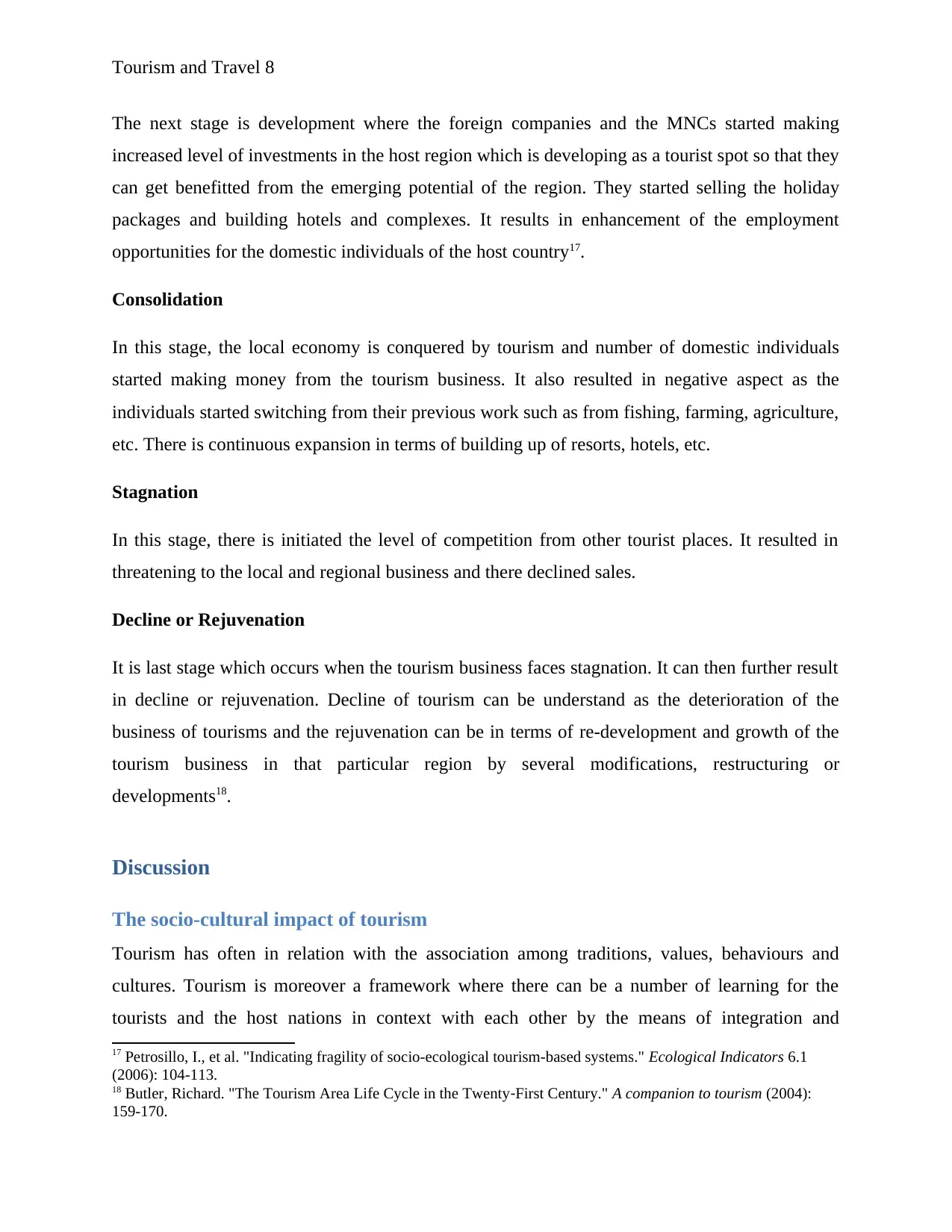
Tourism and Travel 8
The next stage is development where the foreign companies and the MNCs started making
increased level of investments in the host region which is developing as a tourist spot so that they
can get benefitted from the emerging potential of the region. They started selling the holiday
packages and building hotels and complexes. It results in enhancement of the employment
opportunities for the domestic individuals of the host country17.
Consolidation
In this stage, the local economy is conquered by tourism and number of domestic individuals
started making money from the tourism business. It also resulted in negative aspect as the
individuals started switching from their previous work such as from fishing, farming, agriculture,
etc. There is continuous expansion in terms of building up of resorts, hotels, etc.
Stagnation
In this stage, there is initiated the level of competition from other tourist places. It resulted in
threatening to the local and regional business and there declined sales.
Decline or Rejuvenation
It is last stage which occurs when the tourism business faces stagnation. It can then further result
in decline or rejuvenation. Decline of tourism can be understand as the deterioration of the
business of tourisms and the rejuvenation can be in terms of re-development and growth of the
tourism business in that particular region by several modifications, restructuring or
developments18.
Discussion
The socio-cultural impact of tourism
Tourism has often in relation with the association among traditions, values, behaviours and
cultures. Tourism is moreover a framework where there can be a number of learning for the
tourists and the host nations in context with each other by the means of integration and
17 Petrosillo, I., et al. "Indicating fragility of socio-ecological tourism-based systems." Ecological Indicators 6.1
(2006): 104-113.
18 Butler, Richard. "The Tourism Area Life Cycle in the Twenty‐First Century." A companion to tourism (2004):
159-170.
The next stage is development where the foreign companies and the MNCs started making
increased level of investments in the host region which is developing as a tourist spot so that they
can get benefitted from the emerging potential of the region. They started selling the holiday
packages and building hotels and complexes. It results in enhancement of the employment
opportunities for the domestic individuals of the host country17.
Consolidation
In this stage, the local economy is conquered by tourism and number of domestic individuals
started making money from the tourism business. It also resulted in negative aspect as the
individuals started switching from their previous work such as from fishing, farming, agriculture,
etc. There is continuous expansion in terms of building up of resorts, hotels, etc.
Stagnation
In this stage, there is initiated the level of competition from other tourist places. It resulted in
threatening to the local and regional business and there declined sales.
Decline or Rejuvenation
It is last stage which occurs when the tourism business faces stagnation. It can then further result
in decline or rejuvenation. Decline of tourism can be understand as the deterioration of the
business of tourisms and the rejuvenation can be in terms of re-development and growth of the
tourism business in that particular region by several modifications, restructuring or
developments18.
Discussion
The socio-cultural impact of tourism
Tourism has often in relation with the association among traditions, values, behaviours and
cultures. Tourism is moreover a framework where there can be a number of learning for the
tourists and the host nations in context with each other by the means of integration and
17 Petrosillo, I., et al. "Indicating fragility of socio-ecological tourism-based systems." Ecological Indicators 6.1
(2006): 104-113.
18 Butler, Richard. "The Tourism Area Life Cycle in the Twenty‐First Century." A companion to tourism (2004):
159-170.
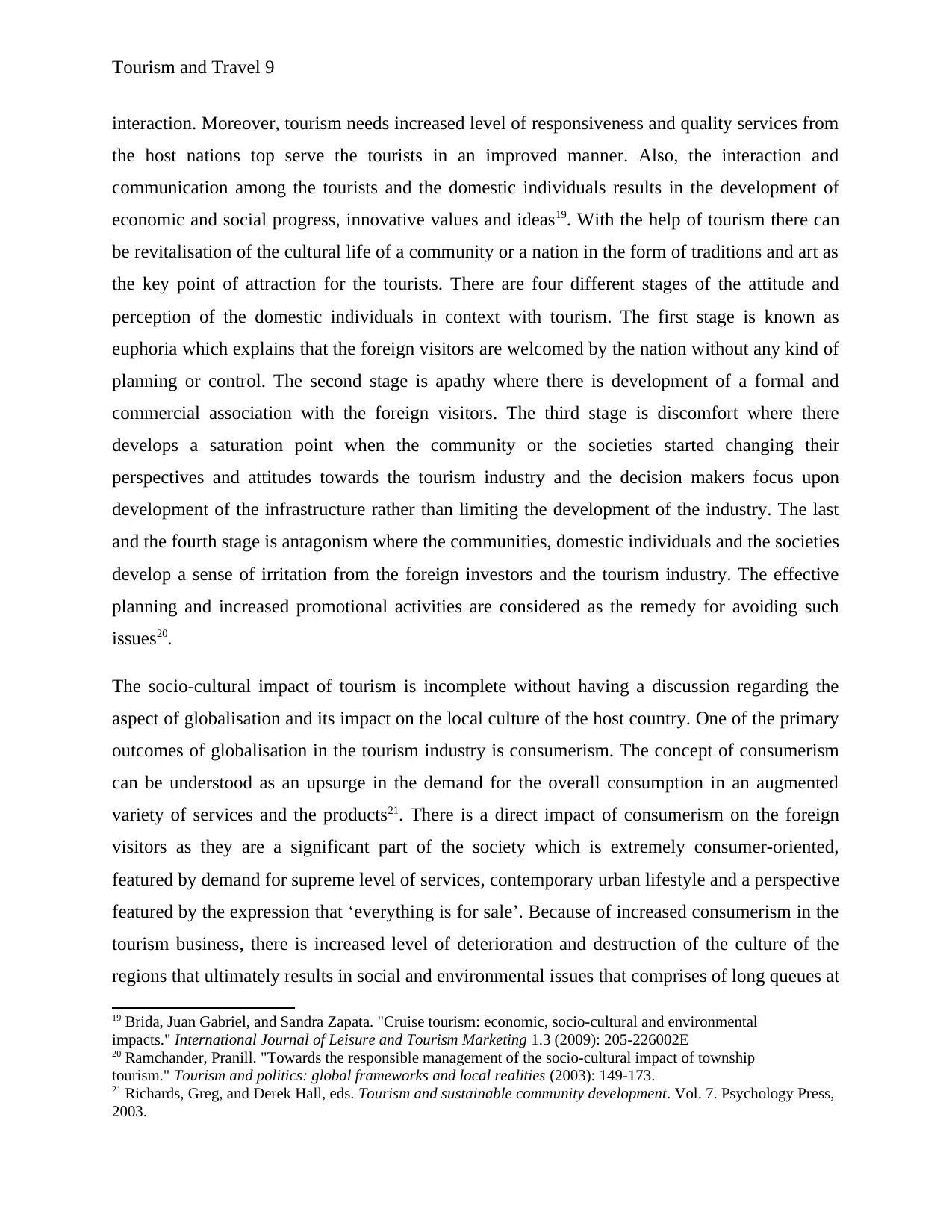
Tourism and Travel 9
interaction. Moreover, tourism needs increased level of responsiveness and quality services from
the host nations top serve the tourists in an improved manner. Also, the interaction and
communication among the tourists and the domestic individuals results in the development of
economic and social progress, innovative values and ideas19. With the help of tourism there can
be revitalisation of the cultural life of a community or a nation in the form of traditions and art as
the key point of attraction for the tourists. There are four different stages of the attitude and
perception of the domestic individuals in context with tourism. The first stage is known as
euphoria which explains that the foreign visitors are welcomed by the nation without any kind of
planning or control. The second stage is apathy where there is development of a formal and
commercial association with the foreign visitors. The third stage is discomfort where there
develops a saturation point when the community or the societies started changing their
perspectives and attitudes towards the tourism industry and the decision makers focus upon
development of the infrastructure rather than limiting the development of the industry. The last
and the fourth stage is antagonism where the communities, domestic individuals and the societies
develop a sense of irritation from the foreign investors and the tourism industry. The effective
planning and increased promotional activities are considered as the remedy for avoiding such
issues20.
The socio-cultural impact of tourism is incomplete without having a discussion regarding the
aspect of globalisation and its impact on the local culture of the host country. One of the primary
outcomes of globalisation in the tourism industry is consumerism. The concept of consumerism
can be understood as an upsurge in the demand for the overall consumption in an augmented
variety of services and the products21. There is a direct impact of consumerism on the foreign
visitors as they are a significant part of the society which is extremely consumer-oriented,
featured by demand for supreme level of services, contemporary urban lifestyle and a perspective
featured by the expression that ‘everything is for sale’. Because of increased consumerism in the
tourism business, there is increased level of deterioration and destruction of the culture of the
regions that ultimately results in social and environmental issues that comprises of long queues at
19 Brida, Juan Gabriel, and Sandra Zapata. "Cruise tourism: economic, socio-cultural and environmental
impacts." International Journal of Leisure and Tourism Marketing 1.3 (2009): 205-226002E
20 Ramchander, Pranill. "Towards the responsible management of the socio-cultural impact of township
tourism." Tourism and politics: global frameworks and local realities (2003): 149-173.
21 Richards, Greg, and Derek Hall, eds. Tourism and sustainable community development. Vol. 7. Psychology Press,
2003.
interaction. Moreover, tourism needs increased level of responsiveness and quality services from
the host nations top serve the tourists in an improved manner. Also, the interaction and
communication among the tourists and the domestic individuals results in the development of
economic and social progress, innovative values and ideas19. With the help of tourism there can
be revitalisation of the cultural life of a community or a nation in the form of traditions and art as
the key point of attraction for the tourists. There are four different stages of the attitude and
perception of the domestic individuals in context with tourism. The first stage is known as
euphoria which explains that the foreign visitors are welcomed by the nation without any kind of
planning or control. The second stage is apathy where there is development of a formal and
commercial association with the foreign visitors. The third stage is discomfort where there
develops a saturation point when the community or the societies started changing their
perspectives and attitudes towards the tourism industry and the decision makers focus upon
development of the infrastructure rather than limiting the development of the industry. The last
and the fourth stage is antagonism where the communities, domestic individuals and the societies
develop a sense of irritation from the foreign investors and the tourism industry. The effective
planning and increased promotional activities are considered as the remedy for avoiding such
issues20.
The socio-cultural impact of tourism is incomplete without having a discussion regarding the
aspect of globalisation and its impact on the local culture of the host country. One of the primary
outcomes of globalisation in the tourism industry is consumerism. The concept of consumerism
can be understood as an upsurge in the demand for the overall consumption in an augmented
variety of services and the products21. There is a direct impact of consumerism on the foreign
visitors as they are a significant part of the society which is extremely consumer-oriented,
featured by demand for supreme level of services, contemporary urban lifestyle and a perspective
featured by the expression that ‘everything is for sale’. Because of increased consumerism in the
tourism business, there is increased level of deterioration and destruction of the culture of the
regions that ultimately results in social and environmental issues that comprises of long queues at
19 Brida, Juan Gabriel, and Sandra Zapata. "Cruise tourism: economic, socio-cultural and environmental
impacts." International Journal of Leisure and Tourism Marketing 1.3 (2009): 205-226002E
20 Ramchander, Pranill. "Towards the responsible management of the socio-cultural impact of township
tourism." Tourism and politics: global frameworks and local realities (2003): 149-173.
21 Richards, Greg, and Derek Hall, eds. Tourism and sustainable community development. Vol. 7. Psychology Press,
2003.
⊘ This is a preview!⊘
Do you want full access?
Subscribe today to unlock all pages.

Trusted by 1+ million students worldwide
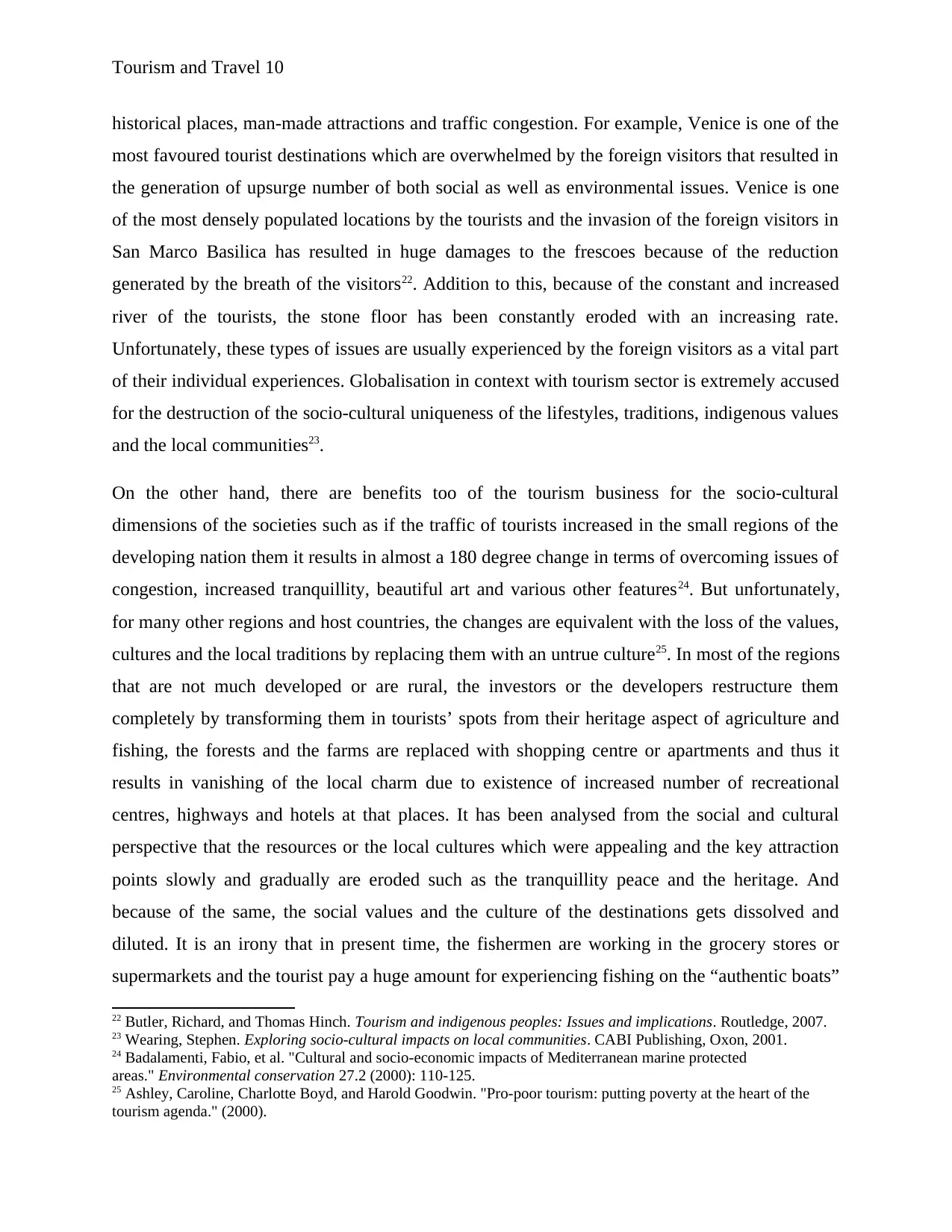
Tourism and Travel 10
historical places, man-made attractions and traffic congestion. For example, Venice is one of the
most favoured tourist destinations which are overwhelmed by the foreign visitors that resulted in
the generation of upsurge number of both social as well as environmental issues. Venice is one
of the most densely populated locations by the tourists and the invasion of the foreign visitors in
San Marco Basilica has resulted in huge damages to the frescoes because of the reduction
generated by the breath of the visitors22. Addition to this, because of the constant and increased
river of the tourists, the stone floor has been constantly eroded with an increasing rate.
Unfortunately, these types of issues are usually experienced by the foreign visitors as a vital part
of their individual experiences. Globalisation in context with tourism sector is extremely accused
for the destruction of the socio-cultural uniqueness of the lifestyles, traditions, indigenous values
and the local communities23.
On the other hand, there are benefits too of the tourism business for the socio-cultural
dimensions of the societies such as if the traffic of tourists increased in the small regions of the
developing nation them it results in almost a 180 degree change in terms of overcoming issues of
congestion, increased tranquillity, beautiful art and various other features24. But unfortunately,
for many other regions and host countries, the changes are equivalent with the loss of the values,
cultures and the local traditions by replacing them with an untrue culture25. In most of the regions
that are not much developed or are rural, the investors or the developers restructure them
completely by transforming them in tourists’ spots from their heritage aspect of agriculture and
fishing, the forests and the farms are replaced with shopping centre or apartments and thus it
results in vanishing of the local charm due to existence of increased number of recreational
centres, highways and hotels at that places. It has been analysed from the social and cultural
perspective that the resources or the local cultures which were appealing and the key attraction
points slowly and gradually are eroded such as the tranquillity peace and the heritage. And
because of the same, the social values and the culture of the destinations gets dissolved and
diluted. It is an irony that in present time, the fishermen are working in the grocery stores or
supermarkets and the tourist pay a huge amount for experiencing fishing on the “authentic boats”
22 Butler, Richard, and Thomas Hinch. Tourism and indigenous peoples: Issues and implications. Routledge, 2007.
23 Wearing, Stephen. Exploring socio-cultural impacts on local communities. CABI Publishing, Oxon, 2001.
24 Badalamenti, Fabio, et al. "Cultural and socio-economic impacts of Mediterranean marine protected
areas." Environmental conservation 27.2 (2000): 110-125.
25 Ashley, Caroline, Charlotte Boyd, and Harold Goodwin. "Pro-poor tourism: putting poverty at the heart of the
tourism agenda." (2000).
historical places, man-made attractions and traffic congestion. For example, Venice is one of the
most favoured tourist destinations which are overwhelmed by the foreign visitors that resulted in
the generation of upsurge number of both social as well as environmental issues. Venice is one
of the most densely populated locations by the tourists and the invasion of the foreign visitors in
San Marco Basilica has resulted in huge damages to the frescoes because of the reduction
generated by the breath of the visitors22. Addition to this, because of the constant and increased
river of the tourists, the stone floor has been constantly eroded with an increasing rate.
Unfortunately, these types of issues are usually experienced by the foreign visitors as a vital part
of their individual experiences. Globalisation in context with tourism sector is extremely accused
for the destruction of the socio-cultural uniqueness of the lifestyles, traditions, indigenous values
and the local communities23.
On the other hand, there are benefits too of the tourism business for the socio-cultural
dimensions of the societies such as if the traffic of tourists increased in the small regions of the
developing nation them it results in almost a 180 degree change in terms of overcoming issues of
congestion, increased tranquillity, beautiful art and various other features24. But unfortunately,
for many other regions and host countries, the changes are equivalent with the loss of the values,
cultures and the local traditions by replacing them with an untrue culture25. In most of the regions
that are not much developed or are rural, the investors or the developers restructure them
completely by transforming them in tourists’ spots from their heritage aspect of agriculture and
fishing, the forests and the farms are replaced with shopping centre or apartments and thus it
results in vanishing of the local charm due to existence of increased number of recreational
centres, highways and hotels at that places. It has been analysed from the social and cultural
perspective that the resources or the local cultures which were appealing and the key attraction
points slowly and gradually are eroded such as the tranquillity peace and the heritage. And
because of the same, the social values and the culture of the destinations gets dissolved and
diluted. It is an irony that in present time, the fishermen are working in the grocery stores or
supermarkets and the tourist pay a huge amount for experiencing fishing on the “authentic boats”
22 Butler, Richard, and Thomas Hinch. Tourism and indigenous peoples: Issues and implications. Routledge, 2007.
23 Wearing, Stephen. Exploring socio-cultural impacts on local communities. CABI Publishing, Oxon, 2001.
24 Badalamenti, Fabio, et al. "Cultural and socio-economic impacts of Mediterranean marine protected
areas." Environmental conservation 27.2 (2000): 110-125.
25 Ashley, Caroline, Charlotte Boyd, and Harold Goodwin. "Pro-poor tourism: putting poverty at the heart of the
tourism agenda." (2000).
Paraphrase This Document
Need a fresh take? Get an instant paraphrase of this document with our AI Paraphraser
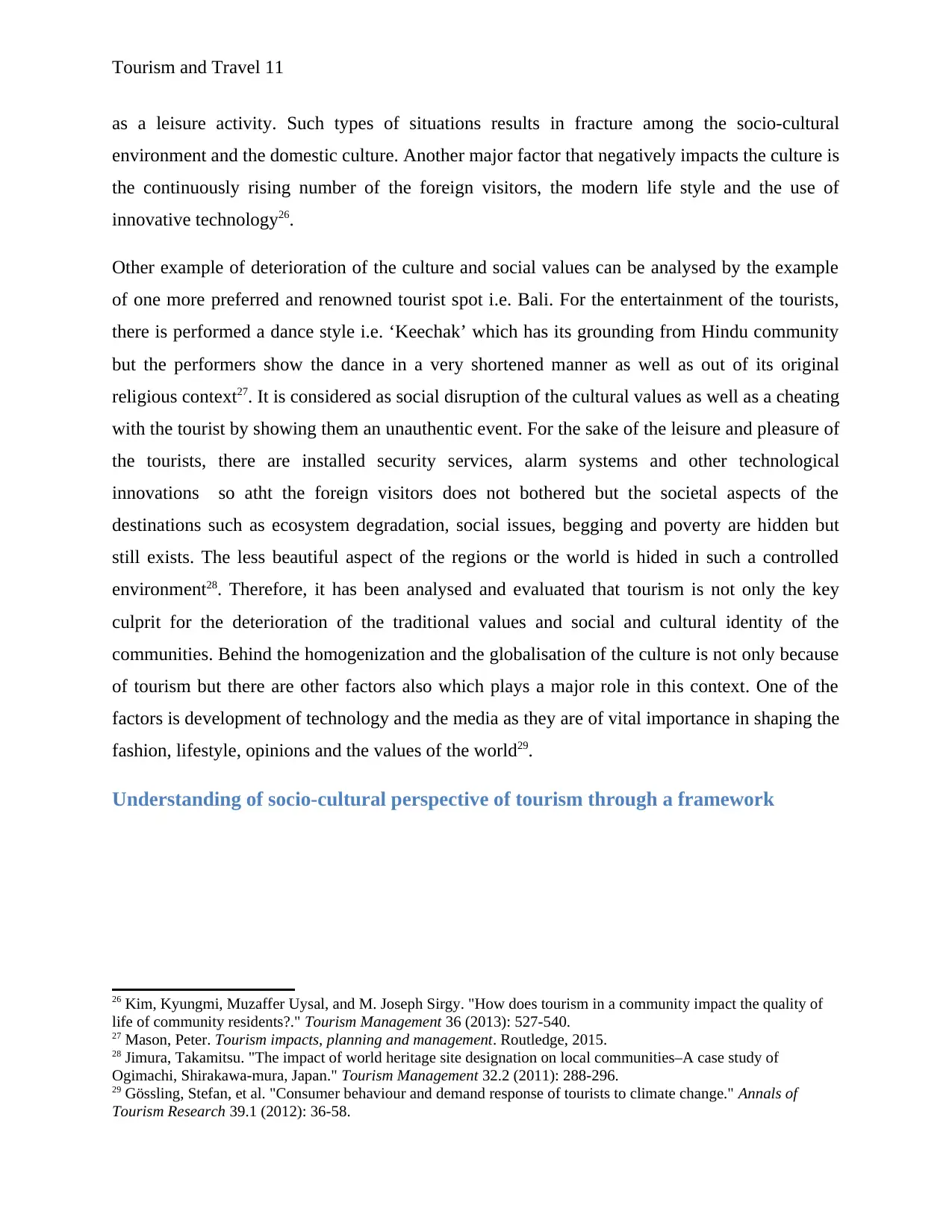
Tourism and Travel 11
as a leisure activity. Such types of situations results in fracture among the socio-cultural
environment and the domestic culture. Another major factor that negatively impacts the culture is
the continuously rising number of the foreign visitors, the modern life style and the use of
innovative technology26.
Other example of deterioration of the culture and social values can be analysed by the example
of one more preferred and renowned tourist spot i.e. Bali. For the entertainment of the tourists,
there is performed a dance style i.e. ‘Keechak’ which has its grounding from Hindu community
but the performers show the dance in a very shortened manner as well as out of its original
religious context27. It is considered as social disruption of the cultural values as well as a cheating
with the tourist by showing them an unauthentic event. For the sake of the leisure and pleasure of
the tourists, there are installed security services, alarm systems and other technological
innovations so atht the foreign visitors does not bothered but the societal aspects of the
destinations such as ecosystem degradation, social issues, begging and poverty are hidden but
still exists. The less beautiful aspect of the regions or the world is hided in such a controlled
environment28. Therefore, it has been analysed and evaluated that tourism is not only the key
culprit for the deterioration of the traditional values and social and cultural identity of the
communities. Behind the homogenization and the globalisation of the culture is not only because
of tourism but there are other factors also which plays a major role in this context. One of the
factors is development of technology and the media as they are of vital importance in shaping the
fashion, lifestyle, opinions and the values of the world29.
Understanding of socio-cultural perspective of tourism through a framework
26 Kim, Kyungmi, Muzaffer Uysal, and M. Joseph Sirgy. "How does tourism in a community impact the quality of
life of community residents?." Tourism Management 36 (2013): 527-540.
27 Mason, Peter. Tourism impacts, planning and management. Routledge, 2015.
28 Jimura, Takamitsu. "The impact of world heritage site designation on local communities–A case study of
Ogimachi, Shirakawa-mura, Japan." Tourism Management 32.2 (2011): 288-296.
29 Gössling, Stefan, et al. "Consumer behaviour and demand response of tourists to climate change." Annals of
Tourism Research 39.1 (2012): 36-58.
as a leisure activity. Such types of situations results in fracture among the socio-cultural
environment and the domestic culture. Another major factor that negatively impacts the culture is
the continuously rising number of the foreign visitors, the modern life style and the use of
innovative technology26.
Other example of deterioration of the culture and social values can be analysed by the example
of one more preferred and renowned tourist spot i.e. Bali. For the entertainment of the tourists,
there is performed a dance style i.e. ‘Keechak’ which has its grounding from Hindu community
but the performers show the dance in a very shortened manner as well as out of its original
religious context27. It is considered as social disruption of the cultural values as well as a cheating
with the tourist by showing them an unauthentic event. For the sake of the leisure and pleasure of
the tourists, there are installed security services, alarm systems and other technological
innovations so atht the foreign visitors does not bothered but the societal aspects of the
destinations such as ecosystem degradation, social issues, begging and poverty are hidden but
still exists. The less beautiful aspect of the regions or the world is hided in such a controlled
environment28. Therefore, it has been analysed and evaluated that tourism is not only the key
culprit for the deterioration of the traditional values and social and cultural identity of the
communities. Behind the homogenization and the globalisation of the culture is not only because
of tourism but there are other factors also which plays a major role in this context. One of the
factors is development of technology and the media as they are of vital importance in shaping the
fashion, lifestyle, opinions and the values of the world29.
Understanding of socio-cultural perspective of tourism through a framework
26 Kim, Kyungmi, Muzaffer Uysal, and M. Joseph Sirgy. "How does tourism in a community impact the quality of
life of community residents?." Tourism Management 36 (2013): 527-540.
27 Mason, Peter. Tourism impacts, planning and management. Routledge, 2015.
28 Jimura, Takamitsu. "The impact of world heritage site designation on local communities–A case study of
Ogimachi, Shirakawa-mura, Japan." Tourism Management 32.2 (2011): 288-296.
29 Gössling, Stefan, et al. "Consumer behaviour and demand response of tourists to climate change." Annals of
Tourism Research 39.1 (2012): 36-58.
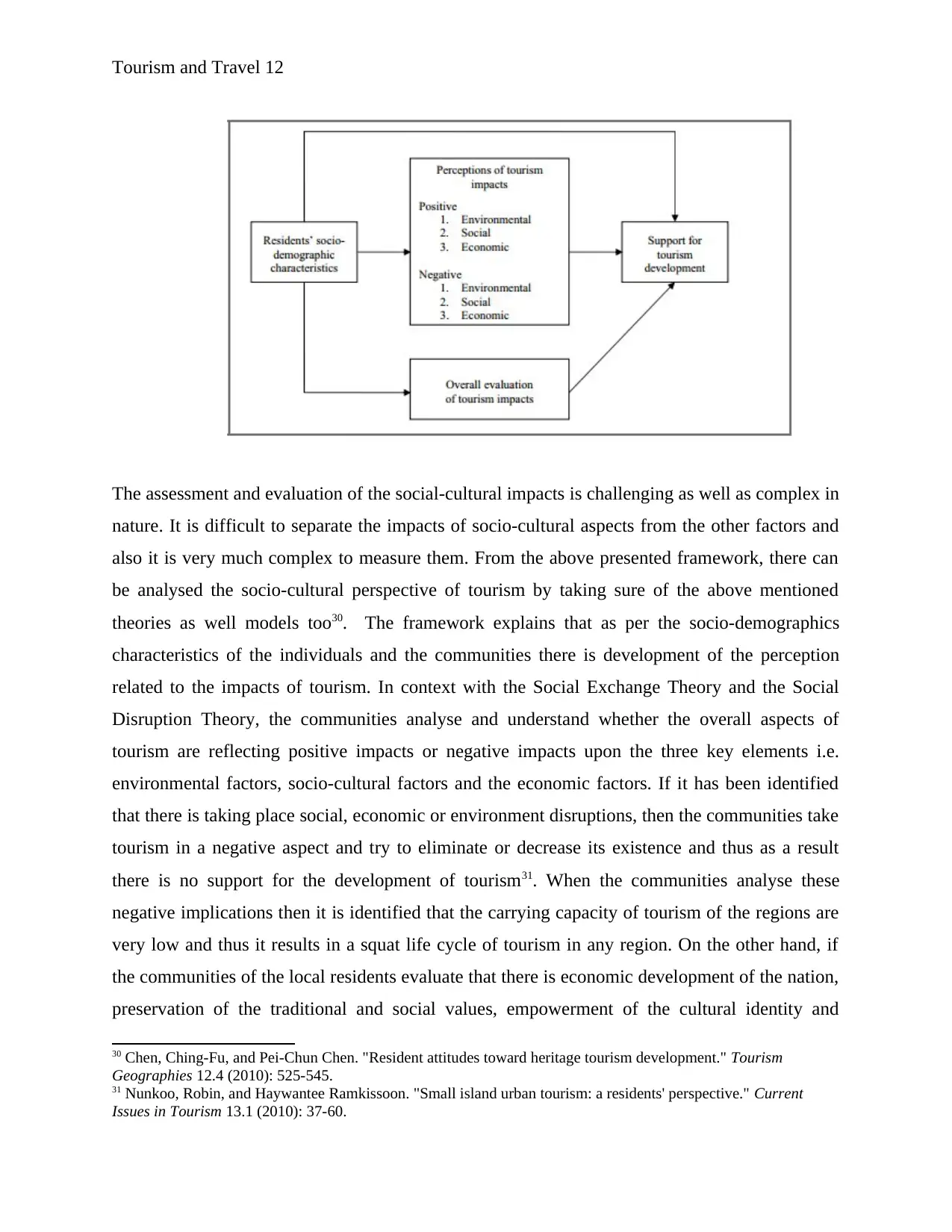
Tourism and Travel 12
The assessment and evaluation of the social-cultural impacts is challenging as well as complex in
nature. It is difficult to separate the impacts of socio-cultural aspects from the other factors and
also it is very much complex to measure them. From the above presented framework, there can
be analysed the socio-cultural perspective of tourism by taking sure of the above mentioned
theories as well models too30. The framework explains that as per the socio-demographics
characteristics of the individuals and the communities there is development of the perception
related to the impacts of tourism. In context with the Social Exchange Theory and the Social
Disruption Theory, the communities analyse and understand whether the overall aspects of
tourism are reflecting positive impacts or negative impacts upon the three key elements i.e.
environmental factors, socio-cultural factors and the economic factors. If it has been identified
that there is taking place social, economic or environment disruptions, then the communities take
tourism in a negative aspect and try to eliminate or decrease its existence and thus as a result
there is no support for the development of tourism31. When the communities analyse these
negative implications then it is identified that the carrying capacity of tourism of the regions are
very low and thus it results in a squat life cycle of tourism in any region. On the other hand, if
the communities of the local residents evaluate that there is economic development of the nation,
preservation of the traditional and social values, empowerment of the cultural identity and
30 Chen, Ching-Fu, and Pei-Chun Chen. "Resident attitudes toward heritage tourism development." Tourism
Geographies 12.4 (2010): 525-545.
31 Nunkoo, Robin, and Haywantee Ramkissoon. "Small island urban tourism: a residents' perspective." Current
Issues in Tourism 13.1 (2010): 37-60.
The assessment and evaluation of the social-cultural impacts is challenging as well as complex in
nature. It is difficult to separate the impacts of socio-cultural aspects from the other factors and
also it is very much complex to measure them. From the above presented framework, there can
be analysed the socio-cultural perspective of tourism by taking sure of the above mentioned
theories as well models too30. The framework explains that as per the socio-demographics
characteristics of the individuals and the communities there is development of the perception
related to the impacts of tourism. In context with the Social Exchange Theory and the Social
Disruption Theory, the communities analyse and understand whether the overall aspects of
tourism are reflecting positive impacts or negative impacts upon the three key elements i.e.
environmental factors, socio-cultural factors and the economic factors. If it has been identified
that there is taking place social, economic or environment disruptions, then the communities take
tourism in a negative aspect and try to eliminate or decrease its existence and thus as a result
there is no support for the development of tourism31. When the communities analyse these
negative implications then it is identified that the carrying capacity of tourism of the regions are
very low and thus it results in a squat life cycle of tourism in any region. On the other hand, if
the communities of the local residents evaluate that there is economic development of the nation,
preservation of the traditional and social values, empowerment of the cultural identity and
30 Chen, Ching-Fu, and Pei-Chun Chen. "Resident attitudes toward heritage tourism development." Tourism
Geographies 12.4 (2010): 525-545.
31 Nunkoo, Robin, and Haywantee Ramkissoon. "Small island urban tourism: a residents' perspective." Current
Issues in Tourism 13.1 (2010): 37-60.
⊘ This is a preview!⊘
Do you want full access?
Subscribe today to unlock all pages.

Trusted by 1+ million students worldwide
1 out of 17
Related Documents
Your All-in-One AI-Powered Toolkit for Academic Success.
+13062052269
info@desklib.com
Available 24*7 on WhatsApp / Email
![[object Object]](/_next/static/media/star-bottom.7253800d.svg)
Unlock your academic potential
Copyright © 2020–2025 A2Z Services. All Rights Reserved. Developed and managed by ZUCOL.



